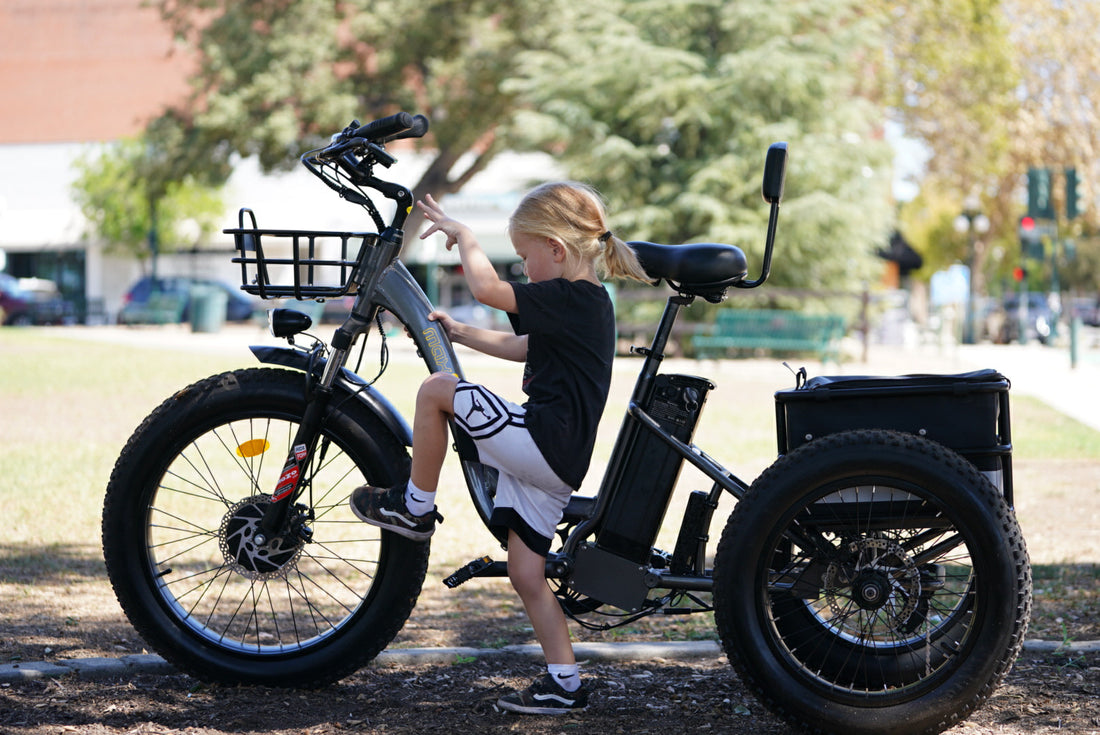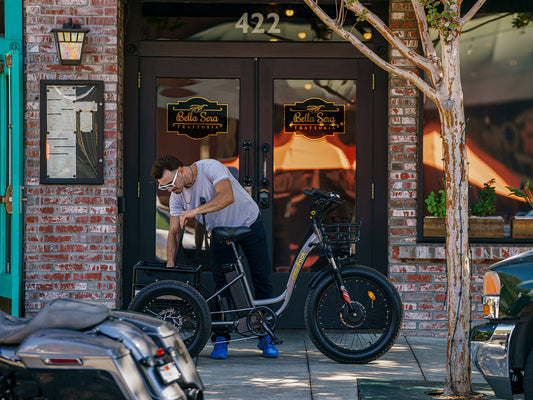The motor in an electric bike is analogous to a car’s engine – it provides the force to move the vehicle. Just as cars have different engine positions and drives, like rear-wheel drive (RWD) and front-wheel drive (FWD), electric bikes feature similar configurations.
In this guide, we will explore the three e-bike motor configurations: front, rear, and mid-drive. We aim to inform you about each type and help you understand which one suits your specific needs.
Hub Motors (Front and Rear)
Hub motors in electric bikes are added to one of the wheels, either at the front or the rear. Apparently, this difference may not seem huge, but the front and rear positioning offers a different riding experience.
Front Drive Motors
Front hub motors are the simplest type of electric bike configuration on the market. In this setup, the motor is located in the front wheel hub. Front wheels receive power and they pull the rear wheels. Imagine it like pulling a cart from the front.
In this case, since the motor is placed on the front, so most of the associated components (derailleur) are also on the front. The rear wheel is free to service and repair. But on the front wheel, you get limited with the use of forks and suspension. Also, most weight hangs in there.
Best Use Cases:
Front hub motors are well-suited for:
Flat Terrain Riding: Commuting or leisure rides on relatively flat terrains where handling and weight distribution are less critical.
Budget-Conscious Riders: Those looking for an affordable entry into the e-bike world without the need for advanced features.
However, bikes with front motors are not suitable for uneven tracks, or steep paths. This is because the bike front’s end is a bit heavier and you need pushing force from behind.
Advantages
- The configuration is simple to maintain.
- Cost-effective choice for bikes.
- Simple replacement.
Disadvantages
- The bike's front end is heavier; handling can be a challenge
- Less traction on unpaved paths
- Difficult to ascend slopes with this configuration
Rear Drive Motors
As the name suggests, the bike is driven from behind. The motor is placed on the rear hub, under the rear seat. This configuration is similar to conventional bikes. It’s like pushing a bike from behind.
In this case, the front end is lightweight and can have any kind of fork suspension. On a slope, when weight is concentrated behind, you need a push from the rear end. That’s where this system excels as you get the necessary traction and force needed.
Compared to the front-drive motors, the structuring is complex but the added benefit of traction outweighs that. The setup pricing is in between the front and hub drive motors. Currently, it’s the most preferred motor configuration for commuter ebikes.
Best Use Cases:
Electric bikes with rear drive motors are best suited for:
City Riding: Suitable for those valuing ride feel over low maintenance, and not needing internal hub gears.
Off-Road and Steep Terrain: Ideal for riders frequently tackling rough, steep tracks.
High-End E-Bikes: Best on premium bikes with durable rear wheels and high-quality components.
Advantages
- Great for adverse conditions.
- Weight on the rear wheel reduces vibrations and noise.
- Capable of moving weights.
- Flexibility with the use of front forks
Drawbacks
- Changing the rear wheel can be a challenge.
- More stress on the rear wheel.
- The bike gets heavier on the rear end.
Mid-Drive Motors
In a mid-drive setup, the motor is placed in the center near the pedal, in between the front and rear hubs. Unlike the hub motor setup, it neither pushes nor pulls the bike from one end. Instead, there’s a complex gearing system with a chain that transmits equal power to the front and rear wheels – so neither wheel is stressed. It’s more like how you pedal a conventional bicycle.
The motor placement in the center balances the weight plus the motor is usually lower than the frame. This lower center of gravity adds stability. The front and rear end are also free – that means any type of fork configuration can be added.
These bikes are lightweight and the addition of a complex gearing system makes it quite easy to ascend hills. Traction is the best among the three.
However, the setup is quite expensive compared to three and we usually see it in high-end mountain ebikes only.
Best Use Cases:
Mid-drivetrain motors are well-suited for these situations:
Mountain Biking: Ideal for off-road and mountainous terrains. The motor's placement aids in tough climbs.
Balanced Riding: Good for those who want a bike that feels stable and even.
Long Rides: Suitable for long-distance rides where comfort and efficiency are key.
Advantages
- Lower center of gravity; balanced weight
- Best for hilly terrain
- Provides a natural ride feel.
Drawbacks
- Higher Cost
- Frequent Maintenance Needs
Which Motor Should You Choose?
As we have explained in detail the workings and use cases of each motor type, by now you would have got a better idea of each motor configuration. When choosing an ebike based on that, consider your riding style, terrain, and personal preferences.
For those interested in premium mountain e-bikes, mid-drive motors are a compelling option. Their efficient power distribution and superior performance on hilly terrain make them ideal for challenging off-road adventures.
However, for regular leisure rides, commuting, or trikes use, rear-wheel drive motors are the best choice. They provide a good balance of traction, a natural riding feel, and control.
Maxfoot Ebikes Motor Configuration
All Maxfoot bikes are equipped with rear hub motors. This design choice helps us reduce costs while still offering riders the best experience possible.
We are excited to announce that we have recently upgraded our trike, the MF-30, with a rear-hub motor. Check it out now.




